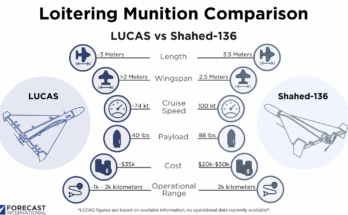The Netherlands is reinvesting in its firepower capabilities following a long period in which its military was downsized and stripped of its fighting edge. The Dutch Defense Ministry is in the process of acquiring long-range solutions for use in the air, sea, and land domains.
The impetus behind this effort is Russia’s ongoing invasion of Ukraine, which has changed the calculus in defense planning across the European continent and particularly that of the Dutch government.
Along with numerous other European nations, shortly after Russia launched its invasion the Netherlands opted to reexamine its approach to defense and security, and on June 1, 2022, unveiled an updated Defense White Paper.
The new strategy aims to reverse the decades-long erosion of the Dutch force structure and improve the military’s resilience and logistical and medical tooth-to-tail strength. The first order of business under the new strategy involves updating and increasing the inventories of ammunition, rockets, missiles, small arms, and fuel, while tackling equipment maintenance backlogs.
Adding more lethal, long-distance firepower to the Dutch Air Force, Army and Navy will enable the Netherlands to be a greater contributor to NATO missions. Therefore, the Defense Ministry is procuring American- and Israeli-made systems, including the Joint Air-to-Surface Standoff Missile Extended Range (JASSM-ER) for the Air Force’s F-35 Lightning II combat aircraft, Tomahawk land attack missiles for the Navy’s De Zeven Provincien class frigates and Walrus class submarines, and the Israeli Precise and Universal Launch System (PULS) for the Army.
Defensie versterkt ook de vuurkracht van de krijgsmacht. Dat gebeurt met de aanschaf van raketartillerie voor de @landmacht en langeafstandswapens voor de @kon_marine en @Kon_Luchtmacht: https://t.co/A8vo1m9a2S pic.twitter.com/fplU0QC2no
— Ministerie van Defensie (@Defensie) April 3, 2023
The Tomahawk has a range of over 1,000 kilometers (621 miles), with the JASSM-ER featuring nearly the same long-range capability.
The Israeli PULS acquisition will provide the Dutch Army with a rocket artillery capability it has gone without since transferring its M270 multiple launch rocket systems (MLRS) to Finland back in 2007. This has left the service relying on its 25 remaining 155mm PzH 2000NL self-propelled howitzers acquired in 2002 and delivered through 2009. Of the 57 units originally purchased, 32 were put up for sale to free up financial space for the Netherlands’ F-35 combat aircraft acquisition.
PULS will give the Dutch Army a “shoot-and-scoot” capability to fire a variety of munitions, including the Predator Hawk with a range of up to 300 kilometers (186 miles).
Perhaps most interesting is that PULS was tapped following an earlier effort by the Netherlands to acquire the in-demand M142 High Mobility Artillery Rocket System (HIMARS) from the U.S. Back on February 16, the Pentagon’s Defense Security Cooperation Agency (DSCA) announced that a potential $670 million Foreign Military Sale (FMS) of 20 HIMARS, as well as multiple missile pods – including the M57 Army Tactical Missile System (ATACMS) – had been cleared by the U.S. State Department.
But instead, the Netherlands is opting for the Israeli system due to its capacity for more rockets (each system comes with two “pods” designed for different rocket types), greater affordability, and suitability for European-made ammunition types.
As for the JASSM-ER, the new missile type will provide the Royal Netherlands Air Force (RNLAF) with a precision-guided, stealthy, long-range capability enabling its fleet of F-35s (which will eventually reach 52 units) to hit targets from afar, thereby minimizing risk to the aircraft from strong enemy air defense networks. Topping this off is that the new missile will come outfitted with a 1,000-pound WDU-42/B bunker-destroying warhead. Hence, a standoff capability ensuring a pricey combat aircraft remains outside a heavily contested area while eliminating air defense elements will serve a vital dual purpose.
The Netherlands has quite a distance to go before reclaiming its former military edge, but an additional top-up of EUR5 billion ($5.47 billion) to the topline defense budget on a structural basis is providing a jump-start to the process. The aim going forward will be to reach NATO’s minimum benchmark for investment in defense of 2 percent of annual GDP in 2024 and 2025 – a far cry from the 1.3 percent allocated in 2019.
The latest acquisitions will be the tip of the spear for a rejuvenated Dutch military long in need of both tooth and tail as it seeks to regain its fighting trim.
Dan Darling is Forecast International’s director of military and defense markets. In this role, Dan oversees a team of analysts tasked with covering everything from budgeting to weapons systems to defense electronics and military aerospace. Additionally, for over 17 years Dan has, at various times, authored the International Military Markets reports for Europe, Eurasia, the Middle East and the Asia-Pacific region.
Dan's work has been cited in Defense News, Real Clear Defense, Asian Military Review, Al Jazeera, and Financial Express, among others, and he has also contributed commentary to The Diplomat, The National Interest and World Politics Review. He has been quoted in Arabian Business, the Financial Times, Flight International, The New York Times, Bloomberg and National Defense Magazine.
In addition, Dan has made guest appearances on the online radio show Midrats and on The Media Line, as well as The Red Line Podcast, plus media appearances on France 24 and World Is One News (WION).




